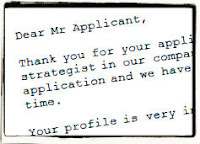Why Well-Crafted Rejection Letters are Cheap PR
Every time I talk to job seekers I hear about companies that don't reply to applicants they don't intend to hire. Perhaps they care little for good manners, but I believe that by doing this they are also going against the interests of their own company.
Either they simply can't empathize with the applicants point of view or they are taking the very narrow view that since they
don’t want a person it doesn’t matter if they hate the company. But this ignores
the possibility that one day you might change your mind and want to hire them.
More importantly it completely ignores the fact that this treatment creates a negative
feeling that often translates into lost sales.
Since I am a consultant it’s been a few years since I went job hunting but I can remember
the names of all the companies that failed to send a polite letter. I still
avoid their products when possible. Another company sent a very polite rejection
letter and I continue to prefer their brand. Failing to send a rejection letter
to unsuccessful candidates is not just a matter of politeness, it is a waste of
an opportunity to do some very cheap PR. Perhaps to the recruiting team these letters are
just a burden, but from the company’s perspective they are a easy way to reinforce
the good feeling towards the company the person must have had if they wanted to
work there in the first place.
Just sending a letter isn’t enough; as usual it’s the details
that count. First of all it should be a personalized letter rather than just a standard response or a form with tickboxes – easy to generate even automatically these days. It should
also thank the person for their interest and maybe even encourage them to try
again In future. But there is also one further technique based on research conducted
a few years ago. Someone tested the impression given by many different rejection letters
and discovered that the length is important. Two paragraphs seemed to be too brusque,
four or more paragraphs seemed too wordy but three had the most impact. Exactly why this magic length works best I cannot say, but based on my own experience helping people with templates I believe that this is because it is hard to make three paragraphs without putting some effort into it, and this extra effort shows.
By leaving unsuccessful applicants to guess they are not
wanted you turn them all against you; for the cost of a few letters you can
give them all a positive feeling towards your company, which would have cost
much more to obtain any other ways. Rejection letters are probably the
cheapest, and most underrated of PR tools.
And if the HR budget doesn’t stretch far eough to pay for this maybe the
PR department can step In to help; it is, after all, in their interest.
Lectures, Workshops, Coaching & Writing
For lectures, workshops, coaching and writing on this and other communication topics visit http://andrewhennigan.com , email speaker@andrewhennigan.com or call 0046 73 089 44 75.




Comments